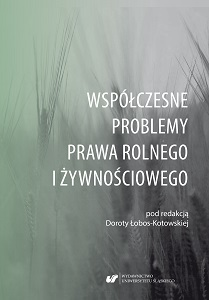Żywność w gospodarce cyrkularnej
Food in the circular economy
Author(s): Joanna Dmowska
Subject(s): Law, Constitution, Jurisprudence
Published by: Wydawnictwo Uniwersytetu Śląskiego
Keywords: circular economy; closed loop economy; linear economy; natural resources; food design; food production; food products; management of wastes; food wastes; catering wastes; municipal wastes; wasting of
Summary/Abstract: The circular economy means the closed loop economy. The assumption of circular economy is to maintain each food product in the economy for as long as possible, to minimize the generation of waste. The food product must be produced and consumed with a view to its further processing and utilizing the food waste in an effective and ecological way. Each stage of a food product’s life is equally important for its further use, since it affects the processes of obtaining secondary raw materials and the use of natural resources. The transition from a linear economy to a circular economy aims to create a sustainable, low-emission, resource-efficient and competitive economy. However, this transformation requires regulatory framework and appropriate tools that will allow, among other things, the implementation of constructive and practical solutions, both in the design and food production phase. These activities could result in the reduction of food waste, increase in the secondary raw materials base and -decrease in the amount of waste incinerated from food. The above is currently implemented through the European Union initiatives that create a new framework for the circular economy for each product. Poland’s response to the invitation to implement the idea of the circular economy are various horizontal actions and defining the most prominent areas for the development of this economic model. The most important, inter alia, are the bioeconomy and sustainable consumption, i.e. the use of food products in a way that minimizes the use of natural resources and waste production.
Book: Współczesne problemy prawa rolnego i żywnościowego
- Page Range: 249- 262
- Page Count: 14
- Publication Year: 2019
- Language: Polish
- Content File-PDF

